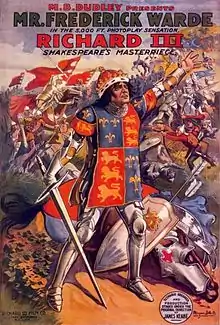Richard III (1912 film)
Richard III is a 55-minute film adaptation of Shakespeare's play, starring Frederick Warde as the title character. The 1912 film, a French/U.S. international co-production, was produced by Film d'Art and released through the independent states rights film distribution system. The film was co-directed by French film director André Calmettes. Richard III was adapted from Shakespeare's original and Colley Cibber's 1699 adaptation by playwright James Keane, who also served as co-director and actor (playing Richmond). The film was shot around Westchester, New York and City Island Long Island Sound.[1]
| Richard III | |
|---|---|
 | |
| Directed by | André Calmettes James Keane |
| Produced by | J. Stuart Blackton M.B. Dudley |
| Written by | James Keane William Shakespeare |
| Starring | Frederick Warde Robert Gemp |
| Distributed by | States Rights Independent Exchanges |
Release date |
|
Running time | 55 min. |
| Country | France United States |
| Language | English |
| Budget | $30,000 (estimated) |
Release and rediscovery
When the film was released in the U.S., actor Frederick Warde would often appear at screenings, giving a short lecture, and then reading extracts from the play during the changing of the reels, which were then called "acts". The film itself begins with Warde, in modern dress, emerging from behind a theatrical curtain and bowing, and concludes with him bowing again, and returning behind the curtain. A traveling actor, Warde discovered it was more economical to single-handedly tour with the film rather than perform the play with an entire theatrical company.[1] The film also features two scenes from 3 Henry VI (the murder of Prince Edward and Richard's murder of Henry VI).[2][3][4]
It is the oldest surviving American feature-length film, and is also thought to be the first feature-length Shakespearean adaptation ever made. As early as 1922, the film was thought lost. It was not until 1996 that a print was discovered, when William Buffum, former projectionist at the Bluebird Theatre in Portland, Oregon, donated his copy to the American Film Institute. The AFI restored the print, transferring it from its nitrate film stock and retouching the hand tinting effect used in the original 1912 release.
On June 26, 2001, Kino International released the film on DVD,[5] with a newly composed score by Ennio Morricone, and a 17-minute documentary film "Rediscovering Richard: Looking Back on a Forgotten Classic".
Cast
- Robert Gemp ... King Edward IV
- Frederick Warde ... Richard, Duke of Gloucester
- Albert Gardner ... Prince Edward of Lancaster
- James Keane ... Earl of Richmond
- George Moss ... Tressel
- Howard Stuart ... Edward
- Virginia Rankin ... York
- Violet Stuart ... Lady Anne Plantagenet
- Carey Lee ... Queen Elizabeth
- Carlotta De Felice ... Princess Elizabeth
See also
References
- p.19 Rothwell, Kenneth S. A History of Shakespeare on Screen: A Century of Film and Television Cambridge University Press, 28 Oct. 2004
- Robert Hamilton Ball, Shakespeare on Silent Film: A Strange Eventful History (London: George Allen and Unwin, 1968), 155–162
- Barbara Freedman, "Critical Junctures in Shakespeare Screen History: The Case of Richard III", in Russell Jackson (ed.), The Cambridge Companion to Shakespeare on Film (Cambridge: Cambridge University Press, 2007), 47–50
- Sabine Schülting, ""We can't hear a word!": Shakespeare in Silent Film", in Stefani Brusberg-Kiermeier and Jörg Helbig (eds.), Sh@kespeare in the Media: From the Globe Theatre to the World Wide Web, 2nd Edition (Frankfurt: Peter Lang, 2010), 132–133
- Tribbey, Ralph (April 12, 2001). "DVD NEWS BRIEFS: Rhino Bows 'Swope'; 'Proof of Life' DVD; 'Jungle Girl' Found; Kino's 'Richard III'". hive4media.com. Archived from the original on April 21, 2001. Retrieved September 1, 2019.
Further reading
- Weinraub, Bernard (September 17, 1996). "Movie History Emerges From a Basement". The New York Times. Retrieved 15 May 2017.